Healthcare: Falls Risk Analysis of Jacob and John Case Studies
VerifiedAdded on 2022/10/06
|10
|2596
|495
Essay
AI Summary
This essay analyzes the falls risk in two case studies: Jacob Murray, a 7-year-old boy with a fractured tibia, and John Ridges, a 72-year-old man with a fractured tibia and osteoporosis. The essay explores how altered mobility, caused by the fractures and other factors such as age and osteoporosis, increases the risk of falls for both patients. It details comprehensive assessment processes, including the 5Ps checklist and the Humpty Dumpty Falls Scale for Jacob, and bone mineral density assessment for John, to identify care needs and modifiable risk factors. The essay then suggests two evidence-based interventions: providing comfort measures like cold packs and passive exercises, tailored to each patient's age and condition. It emphasizes the importance of educating family members on how to implement these interventions and evaluate their effectiveness by monitoring pain levels, mobility, and overall recovery. Finally, the essay highlights the role of family involvement in ensuring proper care and preventing future falls.
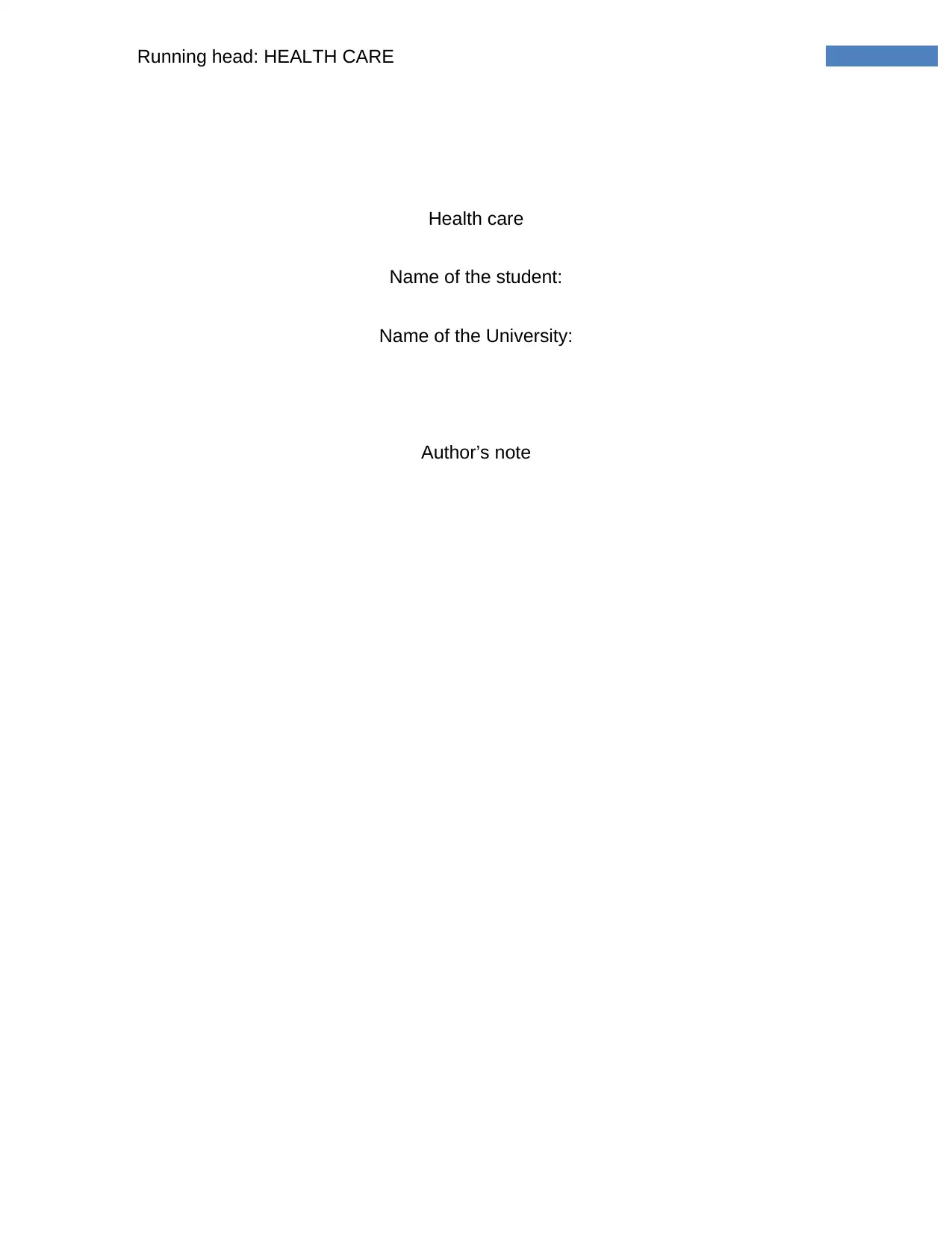
Running head: HEALTH CARE
Health care
Name of the student:
Name of the University:
Author’s note
Health care
Name of the student:
Name of the University:
Author’s note
Paraphrase This Document
Need a fresh take? Get an instant paraphrase of this document with our AI Paraphraser
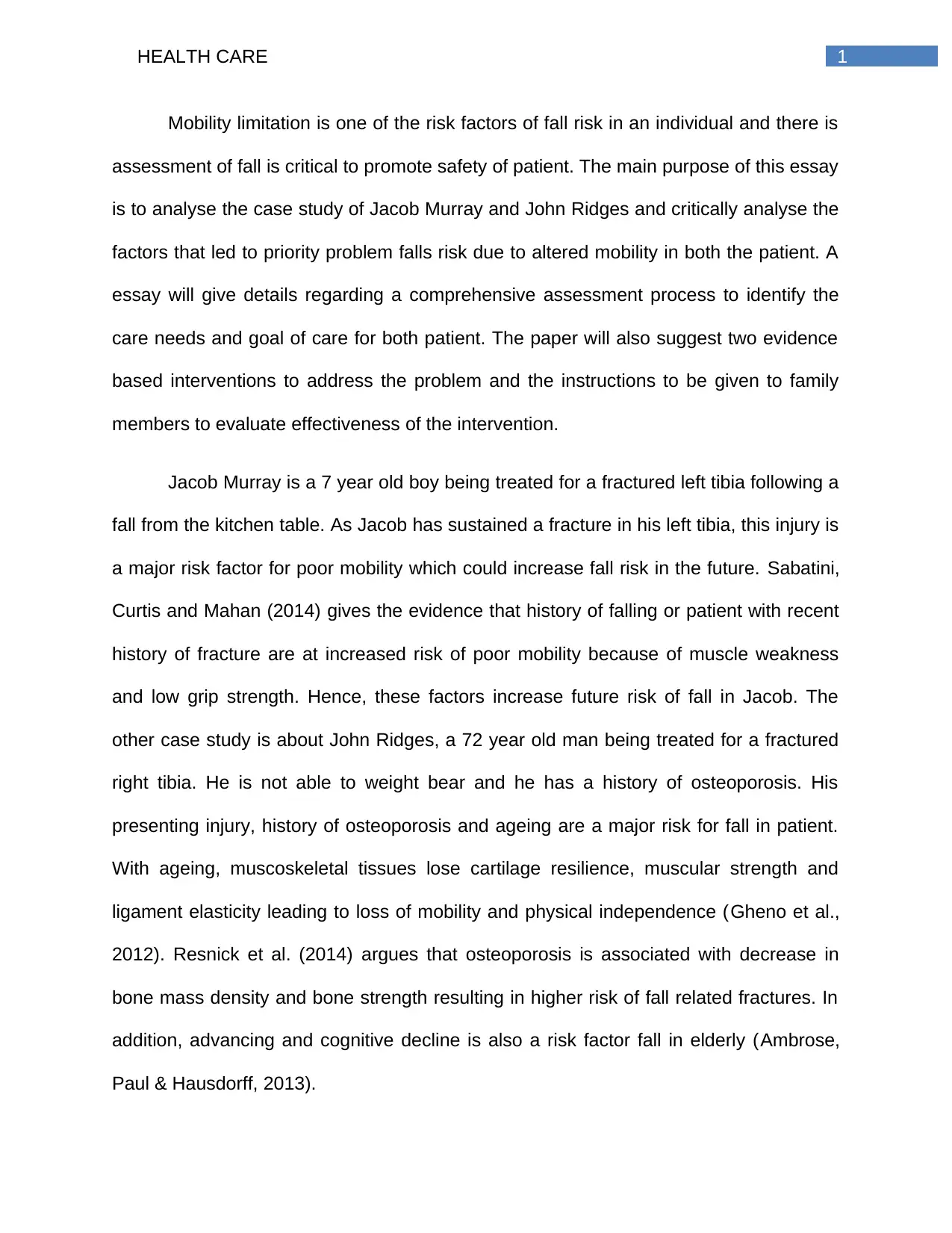
1HEALTH CARE
Mobility limitation is one of the risk factors of fall risk in an individual and there is
assessment of fall is critical to promote safety of patient. The main purpose of this essay
is to analyse the case study of Jacob Murray and John Ridges and critically analyse the
factors that led to priority problem falls risk due to altered mobility in both the patient. A
essay will give details regarding a comprehensive assessment process to identify the
care needs and goal of care for both patient. The paper will also suggest two evidence
based interventions to address the problem and the instructions to be given to family
members to evaluate effectiveness of the intervention.
Jacob Murray is a 7 year old boy being treated for a fractured left tibia following a
fall from the kitchen table. As Jacob has sustained a fracture in his left tibia, this injury is
a major risk factor for poor mobility which could increase fall risk in the future. Sabatini,
Curtis and Mahan (2014) gives the evidence that history of falling or patient with recent
history of fracture are at increased risk of poor mobility because of muscle weakness
and low grip strength. Hence, these factors increase future risk of fall in Jacob. The
other case study is about John Ridges, a 72 year old man being treated for a fractured
right tibia. He is not able to weight bear and he has a history of osteoporosis. His
presenting injury, history of osteoporosis and ageing are a major risk for fall in patient.
With ageing, muscoskeletal tissues lose cartilage resilience, muscular strength and
ligament elasticity leading to loss of mobility and physical independence (Gheno et al.,
2012). Resnick et al. (2014) argues that osteoporosis is associated with decrease in
bone mass density and bone strength resulting in higher risk of fall related fractures. In
addition, advancing and cognitive decline is also a risk factor fall in elderly (Ambrose,
Paul & Hausdorff, 2013).
Mobility limitation is one of the risk factors of fall risk in an individual and there is
assessment of fall is critical to promote safety of patient. The main purpose of this essay
is to analyse the case study of Jacob Murray and John Ridges and critically analyse the
factors that led to priority problem falls risk due to altered mobility in both the patient. A
essay will give details regarding a comprehensive assessment process to identify the
care needs and goal of care for both patient. The paper will also suggest two evidence
based interventions to address the problem and the instructions to be given to family
members to evaluate effectiveness of the intervention.
Jacob Murray is a 7 year old boy being treated for a fractured left tibia following a
fall from the kitchen table. As Jacob has sustained a fracture in his left tibia, this injury is
a major risk factor for poor mobility which could increase fall risk in the future. Sabatini,
Curtis and Mahan (2014) gives the evidence that history of falling or patient with recent
history of fracture are at increased risk of poor mobility because of muscle weakness
and low grip strength. Hence, these factors increase future risk of fall in Jacob. The
other case study is about John Ridges, a 72 year old man being treated for a fractured
right tibia. He is not able to weight bear and he has a history of osteoporosis. His
presenting injury, history of osteoporosis and ageing are a major risk for fall in patient.
With ageing, muscoskeletal tissues lose cartilage resilience, muscular strength and
ligament elasticity leading to loss of mobility and physical independence (Gheno et al.,
2012). Resnick et al. (2014) argues that osteoporosis is associated with decrease in
bone mass density and bone strength resulting in higher risk of fall related fractures. In
addition, advancing and cognitive decline is also a risk factor fall in elderly (Ambrose,
Paul & Hausdorff, 2013).
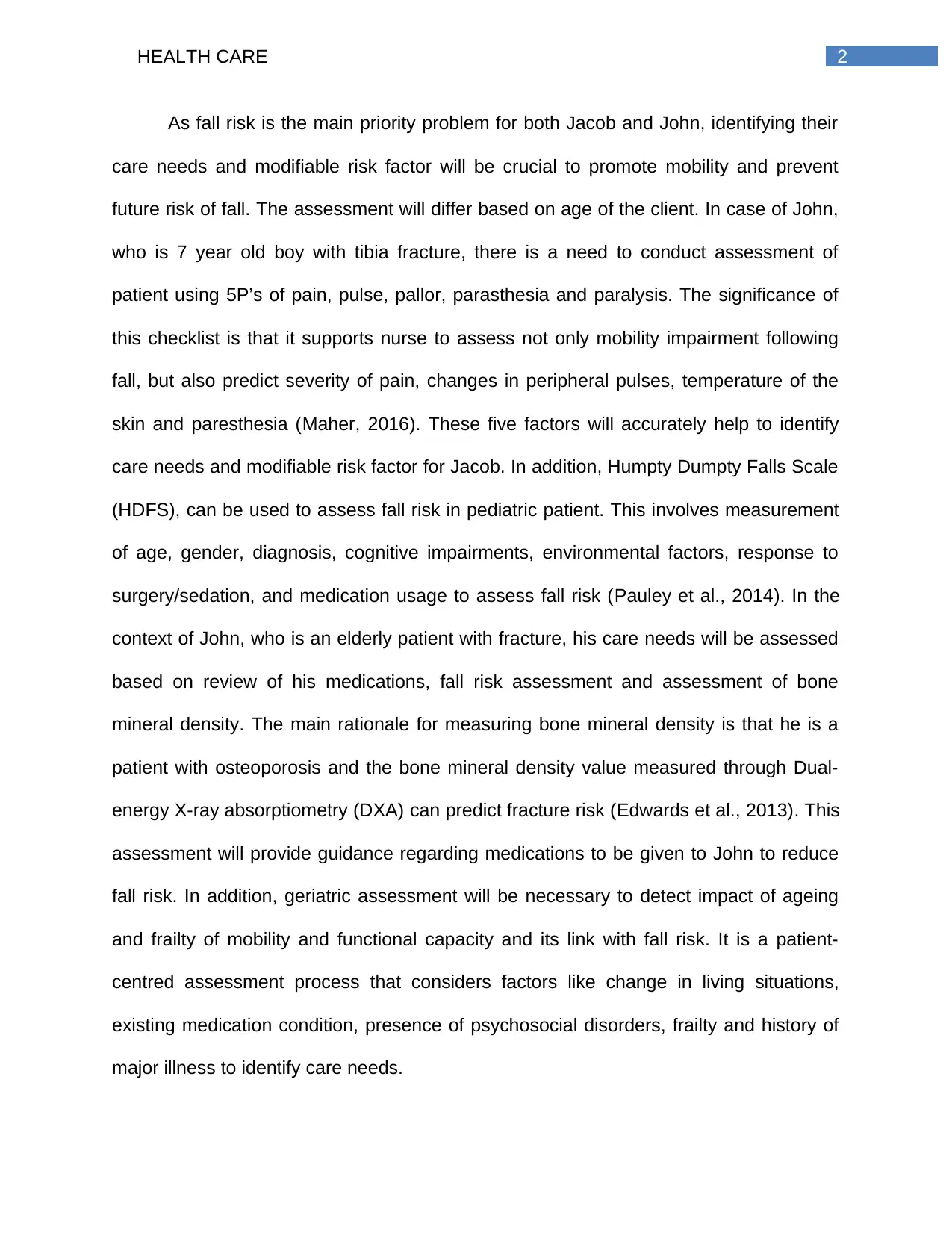
2HEALTH CARE
As fall risk is the main priority problem for both Jacob and John, identifying their
care needs and modifiable risk factor will be crucial to promote mobility and prevent
future risk of fall. The assessment will differ based on age of the client. In case of John,
who is 7 year old boy with tibia fracture, there is a need to conduct assessment of
patient using 5P’s of pain, pulse, pallor, parasthesia and paralysis. The significance of
this checklist is that it supports nurse to assess not only mobility impairment following
fall, but also predict severity of pain, changes in peripheral pulses, temperature of the
skin and paresthesia (Maher, 2016). These five factors will accurately help to identify
care needs and modifiable risk factor for Jacob. In addition, Humpty Dumpty Falls Scale
(HDFS), can be used to assess fall risk in pediatric patient. This involves measurement
of age, gender, diagnosis, cognitive impairments, environmental factors, response to
surgery/sedation, and medication usage to assess fall risk (Pauley et al., 2014). In the
context of John, who is an elderly patient with fracture, his care needs will be assessed
based on review of his medications, fall risk assessment and assessment of bone
mineral density. The main rationale for measuring bone mineral density is that he is a
patient with osteoporosis and the bone mineral density value measured through Dual-
energy X-ray absorptiometry (DXA) can predict fracture risk (Edwards et al., 2013). This
assessment will provide guidance regarding medications to be given to John to reduce
fall risk. In addition, geriatric assessment will be necessary to detect impact of ageing
and frailty of mobility and functional capacity and its link with fall risk. It is a patient-
centred assessment process that considers factors like change in living situations,
existing medication condition, presence of psychosocial disorders, frailty and history of
major illness to identify care needs.
As fall risk is the main priority problem for both Jacob and John, identifying their
care needs and modifiable risk factor will be crucial to promote mobility and prevent
future risk of fall. The assessment will differ based on age of the client. In case of John,
who is 7 year old boy with tibia fracture, there is a need to conduct assessment of
patient using 5P’s of pain, pulse, pallor, parasthesia and paralysis. The significance of
this checklist is that it supports nurse to assess not only mobility impairment following
fall, but also predict severity of pain, changes in peripheral pulses, temperature of the
skin and paresthesia (Maher, 2016). These five factors will accurately help to identify
care needs and modifiable risk factor for Jacob. In addition, Humpty Dumpty Falls Scale
(HDFS), can be used to assess fall risk in pediatric patient. This involves measurement
of age, gender, diagnosis, cognitive impairments, environmental factors, response to
surgery/sedation, and medication usage to assess fall risk (Pauley et al., 2014). In the
context of John, who is an elderly patient with fracture, his care needs will be assessed
based on review of his medications, fall risk assessment and assessment of bone
mineral density. The main rationale for measuring bone mineral density is that he is a
patient with osteoporosis and the bone mineral density value measured through Dual-
energy X-ray absorptiometry (DXA) can predict fracture risk (Edwards et al., 2013). This
assessment will provide guidance regarding medications to be given to John to reduce
fall risk. In addition, geriatric assessment will be necessary to detect impact of ageing
and frailty of mobility and functional capacity and its link with fall risk. It is a patient-
centred assessment process that considers factors like change in living situations,
existing medication condition, presence of psychosocial disorders, frailty and history of
major illness to identify care needs.
⊘ This is a preview!⊘
Do you want full access?
Subscribe today to unlock all pages.

Trusted by 1+ million students worldwide
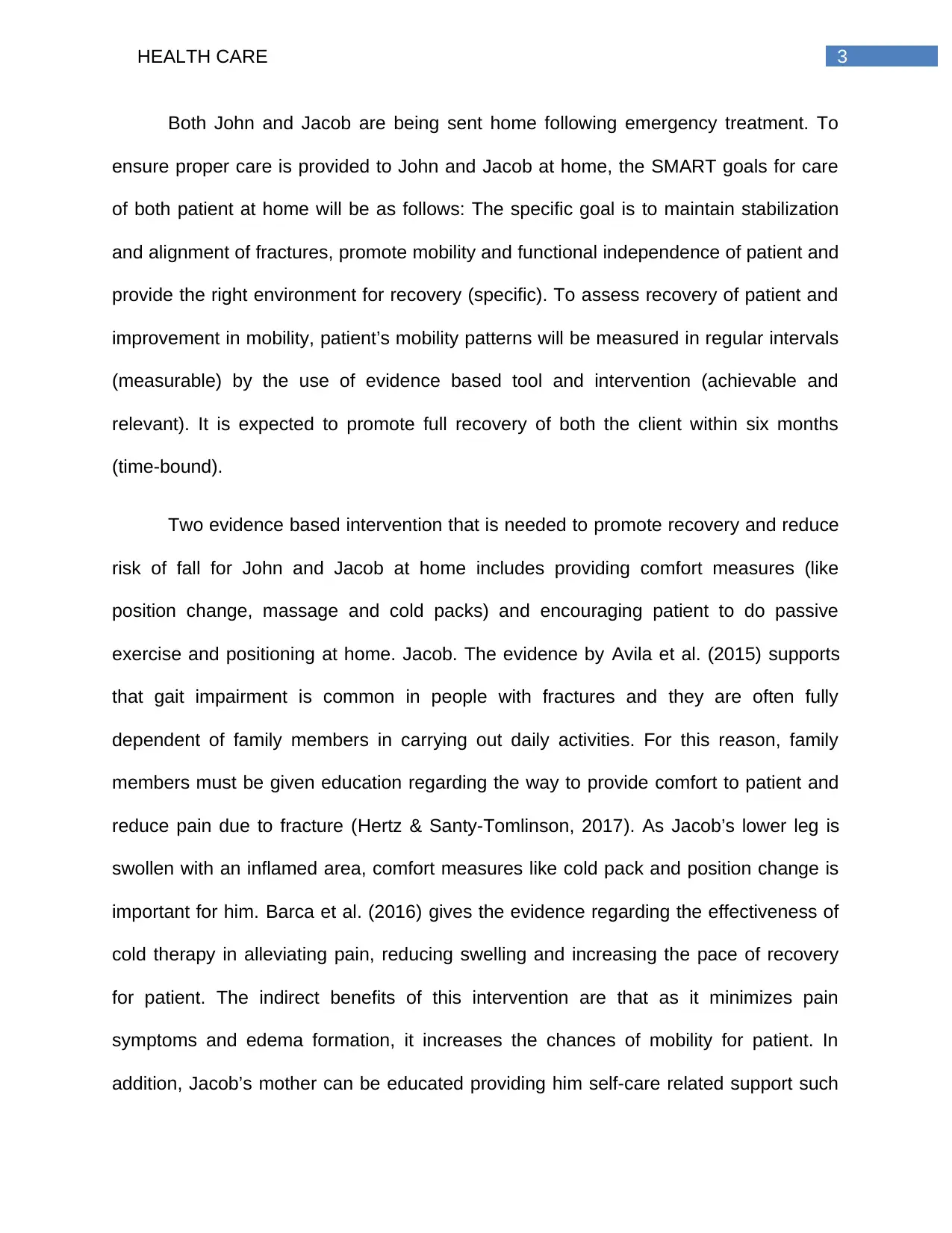
3HEALTH CARE
Both John and Jacob are being sent home following emergency treatment. To
ensure proper care is provided to John and Jacob at home, the SMART goals for care
of both patient at home will be as follows: The specific goal is to maintain stabilization
and alignment of fractures, promote mobility and functional independence of patient and
provide the right environment for recovery (specific). To assess recovery of patient and
improvement in mobility, patient’s mobility patterns will be measured in regular intervals
(measurable) by the use of evidence based tool and intervention (achievable and
relevant). It is expected to promote full recovery of both the client within six months
(time-bound).
Two evidence based intervention that is needed to promote recovery and reduce
risk of fall for John and Jacob at home includes providing comfort measures (like
position change, massage and cold packs) and encouraging patient to do passive
exercise and positioning at home. Jacob. The evidence by Avila et al. (2015) supports
that gait impairment is common in people with fractures and they are often fully
dependent of family members in carrying out daily activities. For this reason, family
members must be given education regarding the way to provide comfort to patient and
reduce pain due to fracture (Hertz & Santy-Tomlinson, 2017). As Jacob’s lower leg is
swollen with an inflamed area, comfort measures like cold pack and position change is
important for him. Barca et al. (2016) gives the evidence regarding the effectiveness of
cold therapy in alleviating pain, reducing swelling and increasing the pace of recovery
for patient. The indirect benefits of this intervention are that as it minimizes pain
symptoms and edema formation, it increases the chances of mobility for patient. In
addition, Jacob’s mother can be educated providing him self-care related support such
Both John and Jacob are being sent home following emergency treatment. To
ensure proper care is provided to John and Jacob at home, the SMART goals for care
of both patient at home will be as follows: The specific goal is to maintain stabilization
and alignment of fractures, promote mobility and functional independence of patient and
provide the right environment for recovery (specific). To assess recovery of patient and
improvement in mobility, patient’s mobility patterns will be measured in regular intervals
(measurable) by the use of evidence based tool and intervention (achievable and
relevant). It is expected to promote full recovery of both the client within six months
(time-bound).
Two evidence based intervention that is needed to promote recovery and reduce
risk of fall for John and Jacob at home includes providing comfort measures (like
position change, massage and cold packs) and encouraging patient to do passive
exercise and positioning at home. Jacob. The evidence by Avila et al. (2015) supports
that gait impairment is common in people with fractures and they are often fully
dependent of family members in carrying out daily activities. For this reason, family
members must be given education regarding the way to provide comfort to patient and
reduce pain due to fracture (Hertz & Santy-Tomlinson, 2017). As Jacob’s lower leg is
swollen with an inflamed area, comfort measures like cold pack and position change is
important for him. Barca et al. (2016) gives the evidence regarding the effectiveness of
cold therapy in alleviating pain, reducing swelling and increasing the pace of recovery
for patient. The indirect benefits of this intervention are that as it minimizes pain
symptoms and edema formation, it increases the chances of mobility for patient. In
addition, Jacob’s mother can be educated providing him self-care related support such
Paraphrase This Document
Need a fresh take? Get an instant paraphrase of this document with our AI Paraphraser
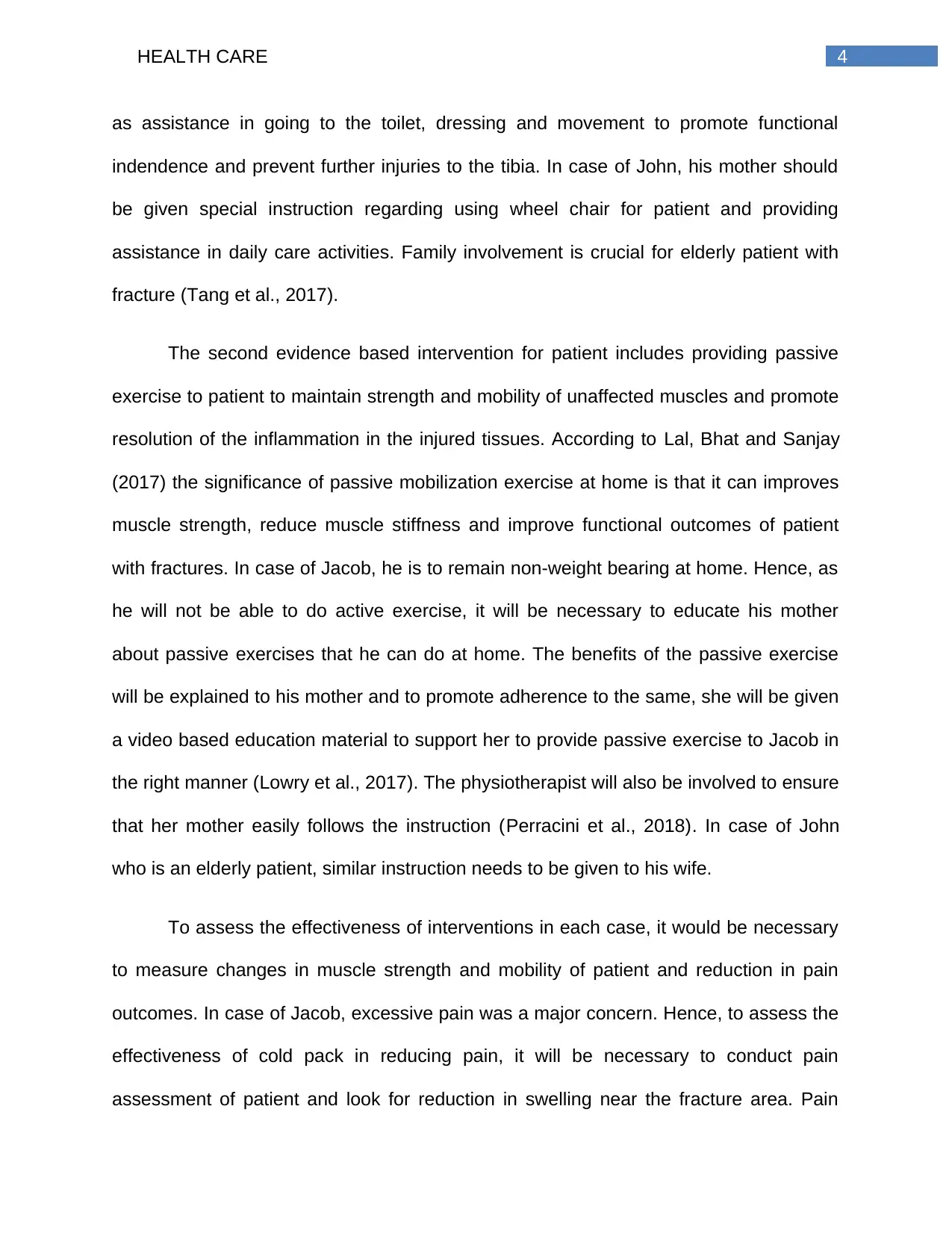
4HEALTH CARE
as assistance in going to the toilet, dressing and movement to promote functional
indendence and prevent further injuries to the tibia. In case of John, his mother should
be given special instruction regarding using wheel chair for patient and providing
assistance in daily care activities. Family involvement is crucial for elderly patient with
fracture (Tang et al., 2017).
The second evidence based intervention for patient includes providing passive
exercise to patient to maintain strength and mobility of unaffected muscles and promote
resolution of the inflammation in the injured tissues. According to Lal, Bhat and Sanjay
(2017) the significance of passive mobilization exercise at home is that it can improves
muscle strength, reduce muscle stiffness and improve functional outcomes of patient
with fractures. In case of Jacob, he is to remain non-weight bearing at home. Hence, as
he will not be able to do active exercise, it will be necessary to educate his mother
about passive exercises that he can do at home. The benefits of the passive exercise
will be explained to his mother and to promote adherence to the same, she will be given
a video based education material to support her to provide passive exercise to Jacob in
the right manner (Lowry et al., 2017). The physiotherapist will also be involved to ensure
that her mother easily follows the instruction (Perracini et al., 2018). In case of John
who is an elderly patient, similar instruction needs to be given to his wife.
To assess the effectiveness of interventions in each case, it would be necessary
to measure changes in muscle strength and mobility of patient and reduction in pain
outcomes. In case of Jacob, excessive pain was a major concern. Hence, to assess the
effectiveness of cold pack in reducing pain, it will be necessary to conduct pain
assessment of patient and look for reduction in swelling near the fracture area. Pain
as assistance in going to the toilet, dressing and movement to promote functional
indendence and prevent further injuries to the tibia. In case of John, his mother should
be given special instruction regarding using wheel chair for patient and providing
assistance in daily care activities. Family involvement is crucial for elderly patient with
fracture (Tang et al., 2017).
The second evidence based intervention for patient includes providing passive
exercise to patient to maintain strength and mobility of unaffected muscles and promote
resolution of the inflammation in the injured tissues. According to Lal, Bhat and Sanjay
(2017) the significance of passive mobilization exercise at home is that it can improves
muscle strength, reduce muscle stiffness and improve functional outcomes of patient
with fractures. In case of Jacob, he is to remain non-weight bearing at home. Hence, as
he will not be able to do active exercise, it will be necessary to educate his mother
about passive exercises that he can do at home. The benefits of the passive exercise
will be explained to his mother and to promote adherence to the same, she will be given
a video based education material to support her to provide passive exercise to Jacob in
the right manner (Lowry et al., 2017). The physiotherapist will also be involved to ensure
that her mother easily follows the instruction (Perracini et al., 2018). In case of John
who is an elderly patient, similar instruction needs to be given to his wife.
To assess the effectiveness of interventions in each case, it would be necessary
to measure changes in muscle strength and mobility of patient and reduction in pain
outcomes. In case of Jacob, excessive pain was a major concern. Hence, to assess the
effectiveness of cold pack in reducing pain, it will be necessary to conduct pain
assessment of patient and look for reduction in swelling near the fracture area. Pain
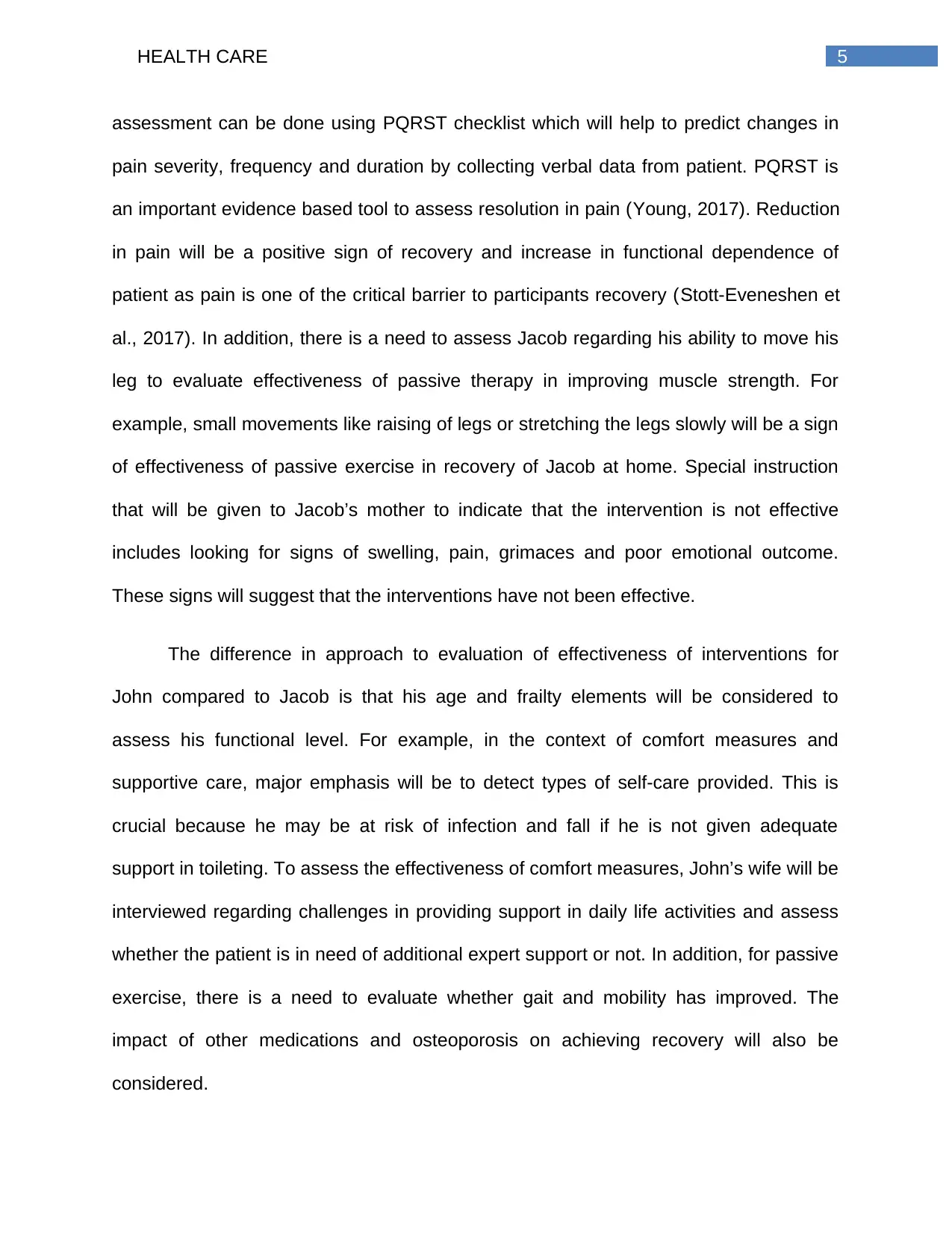
5HEALTH CARE
assessment can be done using PQRST checklist which will help to predict changes in
pain severity, frequency and duration by collecting verbal data from patient. PQRST is
an important evidence based tool to assess resolution in pain (Young, 2017). Reduction
in pain will be a positive sign of recovery and increase in functional dependence of
patient as pain is one of the critical barrier to participants recovery (Stott-Eveneshen et
al., 2017). In addition, there is a need to assess Jacob regarding his ability to move his
leg to evaluate effectiveness of passive therapy in improving muscle strength. For
example, small movements like raising of legs or stretching the legs slowly will be a sign
of effectiveness of passive exercise in recovery of Jacob at home. Special instruction
that will be given to Jacob’s mother to indicate that the intervention is not effective
includes looking for signs of swelling, pain, grimaces and poor emotional outcome.
These signs will suggest that the interventions have not been effective.
The difference in approach to evaluation of effectiveness of interventions for
John compared to Jacob is that his age and frailty elements will be considered to
assess his functional level. For example, in the context of comfort measures and
supportive care, major emphasis will be to detect types of self-care provided. This is
crucial because he may be at risk of infection and fall if he is not given adequate
support in toileting. To assess the effectiveness of comfort measures, John’s wife will be
interviewed regarding challenges in providing support in daily life activities and assess
whether the patient is in need of additional expert support or not. In addition, for passive
exercise, there is a need to evaluate whether gait and mobility has improved. The
impact of other medications and osteoporosis on achieving recovery will also be
considered.
assessment can be done using PQRST checklist which will help to predict changes in
pain severity, frequency and duration by collecting verbal data from patient. PQRST is
an important evidence based tool to assess resolution in pain (Young, 2017). Reduction
in pain will be a positive sign of recovery and increase in functional dependence of
patient as pain is one of the critical barrier to participants recovery (Stott-Eveneshen et
al., 2017). In addition, there is a need to assess Jacob regarding his ability to move his
leg to evaluate effectiveness of passive therapy in improving muscle strength. For
example, small movements like raising of legs or stretching the legs slowly will be a sign
of effectiveness of passive exercise in recovery of Jacob at home. Special instruction
that will be given to Jacob’s mother to indicate that the intervention is not effective
includes looking for signs of swelling, pain, grimaces and poor emotional outcome.
These signs will suggest that the interventions have not been effective.
The difference in approach to evaluation of effectiveness of interventions for
John compared to Jacob is that his age and frailty elements will be considered to
assess his functional level. For example, in the context of comfort measures and
supportive care, major emphasis will be to detect types of self-care provided. This is
crucial because he may be at risk of infection and fall if he is not given adequate
support in toileting. To assess the effectiveness of comfort measures, John’s wife will be
interviewed regarding challenges in providing support in daily life activities and assess
whether the patient is in need of additional expert support or not. In addition, for passive
exercise, there is a need to evaluate whether gait and mobility has improved. The
impact of other medications and osteoporosis on achieving recovery will also be
considered.
⊘ This is a preview!⊘
Do you want full access?
Subscribe today to unlock all pages.

Trusted by 1+ million students worldwide
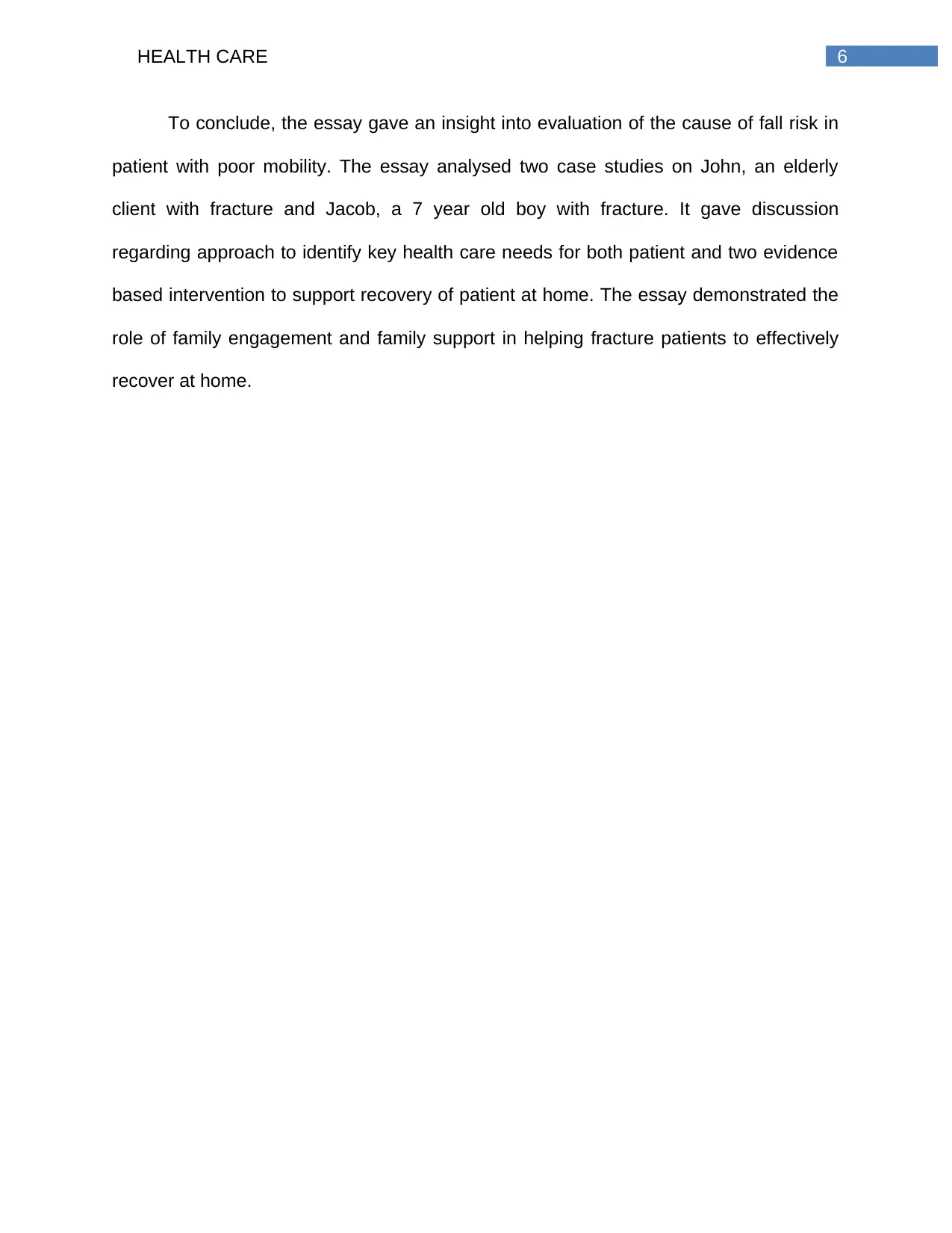
6HEALTH CARE
To conclude, the essay gave an insight into evaluation of the cause of fall risk in
patient with poor mobility. The essay analysed two case studies on John, an elderly
client with fracture and Jacob, a 7 year old boy with fracture. It gave discussion
regarding approach to identify key health care needs for both patient and two evidence
based intervention to support recovery of patient at home. The essay demonstrated the
role of family engagement and family support in helping fracture patients to effectively
recover at home.
To conclude, the essay gave an insight into evaluation of the cause of fall risk in
patient with poor mobility. The essay analysed two case studies on John, an elderly
client with fracture and Jacob, a 7 year old boy with fracture. It gave discussion
regarding approach to identify key health care needs for both patient and two evidence
based intervention to support recovery of patient at home. The essay demonstrated the
role of family engagement and family support in helping fracture patients to effectively
recover at home.
Paraphrase This Document
Need a fresh take? Get an instant paraphrase of this document with our AI Paraphraser
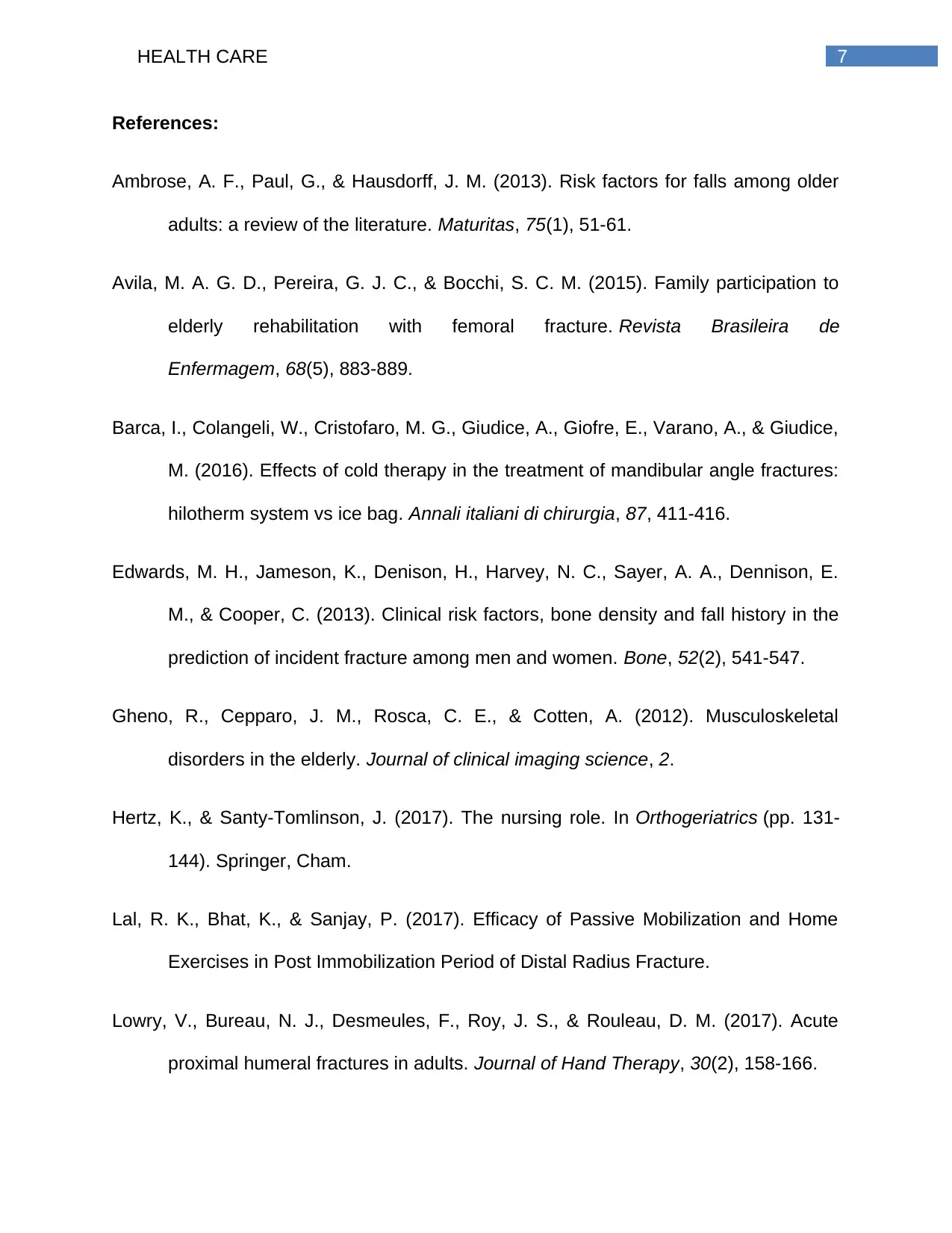
7HEALTH CARE
References:
Ambrose, A. F., Paul, G., & Hausdorff, J. M. (2013). Risk factors for falls among older
adults: a review of the literature. Maturitas, 75(1), 51-61.
Avila, M. A. G. D., Pereira, G. J. C., & Bocchi, S. C. M. (2015). Family participation to
elderly rehabilitation with femoral fracture. Revista Brasileira de
Enfermagem, 68(5), 883-889.
Barca, I., Colangeli, W., Cristofaro, M. G., Giudice, A., Giofre, E., Varano, A., & Giudice,
M. (2016). Effects of cold therapy in the treatment of mandibular angle fractures:
hilotherm system vs ice bag. Annali italiani di chirurgia, 87, 411-416.
Edwards, M. H., Jameson, K., Denison, H., Harvey, N. C., Sayer, A. A., Dennison, E.
M., & Cooper, C. (2013). Clinical risk factors, bone density and fall history in the
prediction of incident fracture among men and women. Bone, 52(2), 541-547.
Gheno, R., Cepparo, J. M., Rosca, C. E., & Cotten, A. (2012). Musculoskeletal
disorders in the elderly. Journal of clinical imaging science, 2.
Hertz, K., & Santy-Tomlinson, J. (2017). The nursing role. In Orthogeriatrics (pp. 131-
144). Springer, Cham.
Lal, R. K., Bhat, K., & Sanjay, P. (2017). Efficacy of Passive Mobilization and Home
Exercises in Post Immobilization Period of Distal Radius Fracture.
Lowry, V., Bureau, N. J., Desmeules, F., Roy, J. S., & Rouleau, D. M. (2017). Acute
proximal humeral fractures in adults. Journal of Hand Therapy, 30(2), 158-166.
References:
Ambrose, A. F., Paul, G., & Hausdorff, J. M. (2013). Risk factors for falls among older
adults: a review of the literature. Maturitas, 75(1), 51-61.
Avila, M. A. G. D., Pereira, G. J. C., & Bocchi, S. C. M. (2015). Family participation to
elderly rehabilitation with femoral fracture. Revista Brasileira de
Enfermagem, 68(5), 883-889.
Barca, I., Colangeli, W., Cristofaro, M. G., Giudice, A., Giofre, E., Varano, A., & Giudice,
M. (2016). Effects of cold therapy in the treatment of mandibular angle fractures:
hilotherm system vs ice bag. Annali italiani di chirurgia, 87, 411-416.
Edwards, M. H., Jameson, K., Denison, H., Harvey, N. C., Sayer, A. A., Dennison, E.
M., & Cooper, C. (2013). Clinical risk factors, bone density and fall history in the
prediction of incident fracture among men and women. Bone, 52(2), 541-547.
Gheno, R., Cepparo, J. M., Rosca, C. E., & Cotten, A. (2012). Musculoskeletal
disorders in the elderly. Journal of clinical imaging science, 2.
Hertz, K., & Santy-Tomlinson, J. (2017). The nursing role. In Orthogeriatrics (pp. 131-
144). Springer, Cham.
Lal, R. K., Bhat, K., & Sanjay, P. (2017). Efficacy of Passive Mobilization and Home
Exercises in Post Immobilization Period of Distal Radius Fracture.
Lowry, V., Bureau, N. J., Desmeules, F., Roy, J. S., & Rouleau, D. M. (2017). Acute
proximal humeral fractures in adults. Journal of Hand Therapy, 30(2), 158-166.
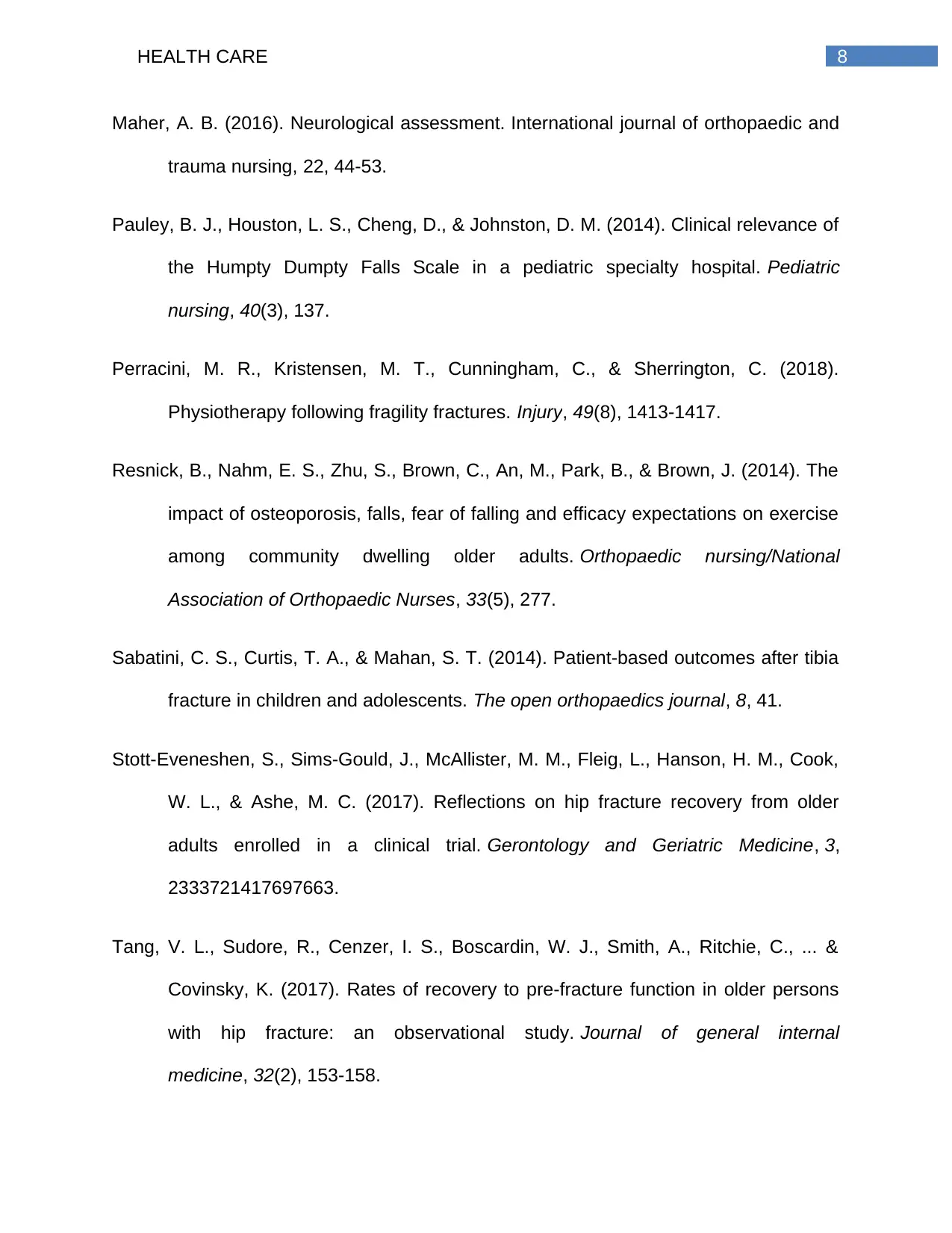
8HEALTH CARE
Maher, A. B. (2016). Neurological assessment. International journal of orthopaedic and
trauma nursing, 22, 44-53.
Pauley, B. J., Houston, L. S., Cheng, D., & Johnston, D. M. (2014). Clinical relevance of
the Humpty Dumpty Falls Scale in a pediatric specialty hospital. Pediatric
nursing, 40(3), 137.
Perracini, M. R., Kristensen, M. T., Cunningham, C., & Sherrington, C. (2018).
Physiotherapy following fragility fractures. Injury, 49(8), 1413-1417.
Resnick, B., Nahm, E. S., Zhu, S., Brown, C., An, M., Park, B., & Brown, J. (2014). The
impact of osteoporosis, falls, fear of falling and efficacy expectations on exercise
among community dwelling older adults. Orthopaedic nursing/National
Association of Orthopaedic Nurses, 33(5), 277.
Sabatini, C. S., Curtis, T. A., & Mahan, S. T. (2014). Patient-based outcomes after tibia
fracture in children and adolescents. The open orthopaedics journal, 8, 41.
Stott-Eveneshen, S., Sims-Gould, J., McAllister, M. M., Fleig, L., Hanson, H. M., Cook,
W. L., & Ashe, M. C. (2017). Reflections on hip fracture recovery from older
adults enrolled in a clinical trial. Gerontology and Geriatric Medicine, 3,
2333721417697663.
Tang, V. L., Sudore, R., Cenzer, I. S., Boscardin, W. J., Smith, A., Ritchie, C., ... &
Covinsky, K. (2017). Rates of recovery to pre-fracture function in older persons
with hip fracture: an observational study. Journal of general internal
medicine, 32(2), 153-158.
Maher, A. B. (2016). Neurological assessment. International journal of orthopaedic and
trauma nursing, 22, 44-53.
Pauley, B. J., Houston, L. S., Cheng, D., & Johnston, D. M. (2014). Clinical relevance of
the Humpty Dumpty Falls Scale in a pediatric specialty hospital. Pediatric
nursing, 40(3), 137.
Perracini, M. R., Kristensen, M. T., Cunningham, C., & Sherrington, C. (2018).
Physiotherapy following fragility fractures. Injury, 49(8), 1413-1417.
Resnick, B., Nahm, E. S., Zhu, S., Brown, C., An, M., Park, B., & Brown, J. (2014). The
impact of osteoporosis, falls, fear of falling and efficacy expectations on exercise
among community dwelling older adults. Orthopaedic nursing/National
Association of Orthopaedic Nurses, 33(5), 277.
Sabatini, C. S., Curtis, T. A., & Mahan, S. T. (2014). Patient-based outcomes after tibia
fracture in children and adolescents. The open orthopaedics journal, 8, 41.
Stott-Eveneshen, S., Sims-Gould, J., McAllister, M. M., Fleig, L., Hanson, H. M., Cook,
W. L., & Ashe, M. C. (2017). Reflections on hip fracture recovery from older
adults enrolled in a clinical trial. Gerontology and Geriatric Medicine, 3,
2333721417697663.
Tang, V. L., Sudore, R., Cenzer, I. S., Boscardin, W. J., Smith, A., Ritchie, C., ... &
Covinsky, K. (2017). Rates of recovery to pre-fracture function in older persons
with hip fracture: an observational study. Journal of general internal
medicine, 32(2), 153-158.
⊘ This is a preview!⊘
Do you want full access?
Subscribe today to unlock all pages.

Trusted by 1+ million students worldwide
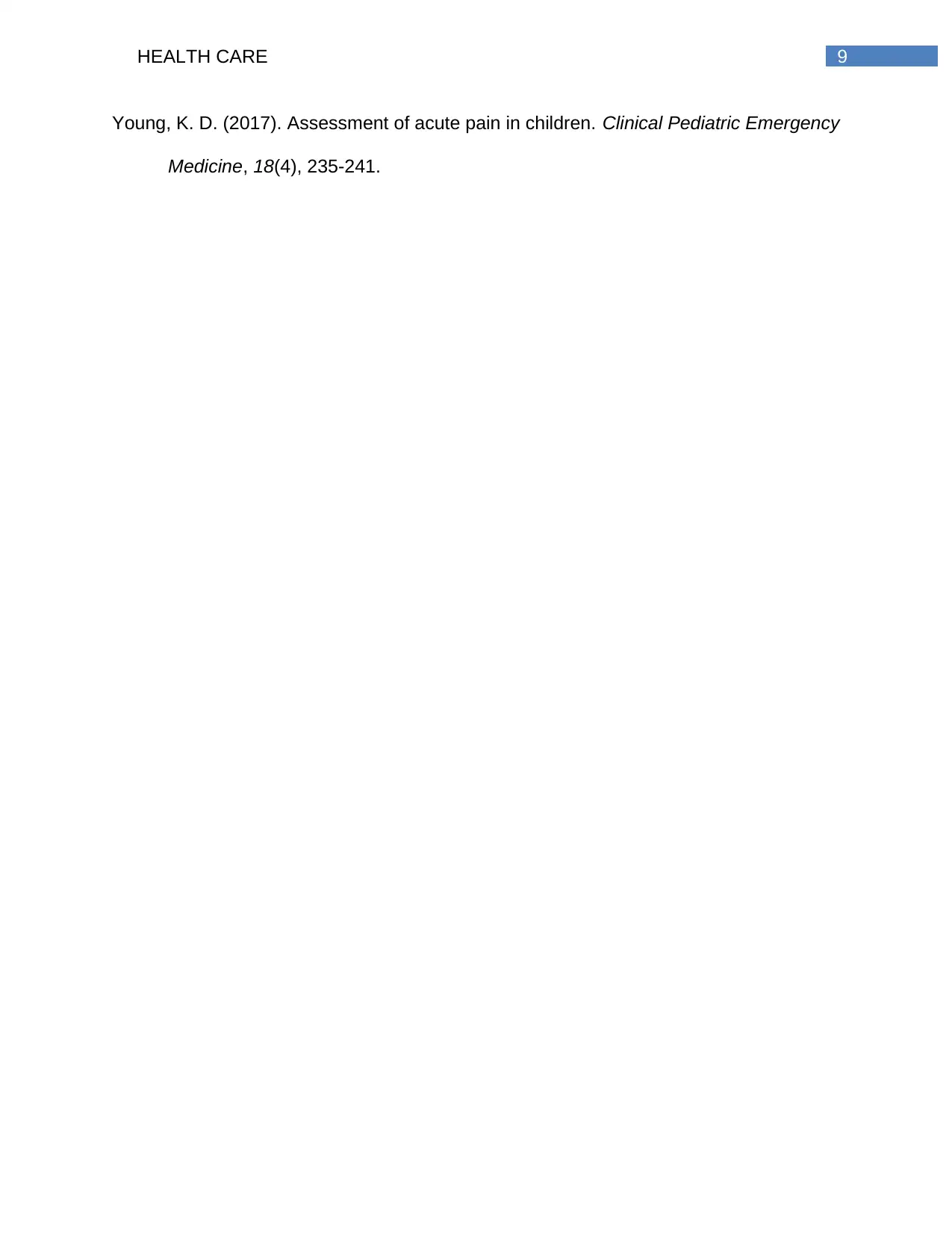
9HEALTH CARE
Young, K. D. (2017). Assessment of acute pain in children. Clinical Pediatric Emergency
Medicine, 18(4), 235-241.
Young, K. D. (2017). Assessment of acute pain in children. Clinical Pediatric Emergency
Medicine, 18(4), 235-241.
1 out of 10
Related Documents
Your All-in-One AI-Powered Toolkit for Academic Success.
+13062052269
info@desklib.com
Available 24*7 on WhatsApp / Email
![[object Object]](/_next/static/media/star-bottom.7253800d.svg)
Unlock your academic potential
Copyright © 2020–2025 A2Z Services. All Rights Reserved. Developed and managed by ZUCOL.




